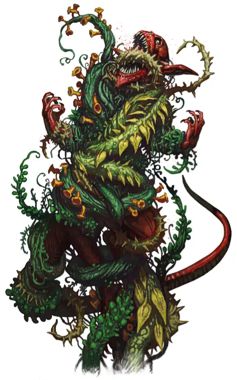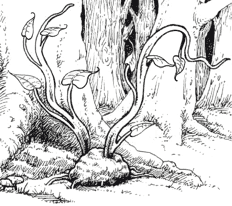

MC Forgotten Realms Appendix II

| Viper Vine | Whipweed | Witherweed | |
|---|---|---|---|
| Vigne-vipère | Herbe-fouet | Herbe étiolée | |
| Climate/Terrain: | Tropical/Forests | Non-arctic/Dark | Non-arctic/Ruins |
| Frequency: | Rare | Uncommon | Uncommon |
| Organization: | Clusters | Solitary | Solitary |
| Activity Cycle: | Any | Any | Any |
| Diet: | Carnivore | Omnivore | Special |
| Intelligence: | Low (5-7) | Semi- (2-4) | Non- (0) |
| Treasure: | Nil | Nil | Nil |
| Alignment: | Neutral | Neutral | Neutral |
| No. Appearing: | 1-10 | 1-2 | 1 |
| Armor Class: | 8 | 6/4 | 8 |
| Movement: | 3 | 3 | 0 |
| Hit Dice: | 4 | 4 | 3-6 |
| THAC0: | 17 | 17 | 3-4 HD: 17 5-6 HD: 15 |
| No. of Attacks: | 1 | 2 | Variable |
| Damage/Attack: | 1-4 | 1-10/1-10 | Nil |
| Special Attacks: | Paralysis, constriction | Frenzy | Dexterity drain |
| Special Defenses: | See below | Nil | Smoke |
| Magic Resistance: | Nil | Nil | Nil |
| Size: | L (20-50’ long) | Variable | Variable |
| Morale: | Elite (13-14) | Average (8-10) | Average (8-10) |
| XP Value: | 270 | 175 | 270 |
Viper vines are thick (three inches in diameter), rope-like vines that are brownish green in color. They are a type of carnivorous plant indigenous to tropical forests, 90% indistinguishable from normal vines.
Viper vines hang from trees, trailing their ends on the ground to snare unwary animals. They have two forms of attack. The first is constriction as they wrap around their victim, much like snakes, causing 1d4 points of damage per round. A successful bend bars/lift gates roll is required to free oneself from the constriction.
The second attack is a paralyzing poison exuded from the skin onto the ensnared creature (successful saving throw vs. poison to avoid). Viper vines can control this poison, generally not using it until after having constricted their victim for 1d4 rounds. The paralysis lasts for 2d4 rounds.
Viper vines are immune to all blunt weapons.

A whipweed has two stalks, thin and whip-like with a few appendages that look like small leaves. When fully grown, the stalks are up to 15 feet long, though smaller specimens are just as common. The stalks are connected to a spheroidal base that contains a small brain and is equipped with eight small legs; the creature is thus capable of limited movement and can pull the root-like appendages up underneath itself to permit locomotion.
A whipweed attacks anything that moves within range of its stalks, each stalk hitting as a monster with 4 Hit Dice and capable of inflicting 1d10 points of damage. The stalks will attack two different victims if two are in range. Damage inflicted upon the stalks do not count toward the body’s hit point total.
If the body is destroyed (reduced to 0 hit points or below) the whipweed dies but the stalks go into a mad frenzy for one round before they go inert. During this time they attack three times each and each attack inflicts double the normal damage if successful.
The whipweed hates sunlight, so it is usually found underground or in the heart of deep forest. It draws its sustenance from the remains of animal prey, though it has no mouth and its food appears to be absorbed by the stalks and transferred internally to the body.
Its need to embed its roots into the earth is not fully understood. It is certain that the creature can survive apparently indefinitely in rocky areas containing virtually no soil, and a small crevice in a rock appears to be quite sufficient to cater to its need to root from time to time.
This strange creature was originally named in the belief that was a plant; though it displays behavior that supports this theory, it also has many qualities that are not plant-like (though druidical spells relating to plants affect it).
This weed appears as a dried-out patch of grass or weeds approximately 20 feet square (3 Hit Dice). Weeds twice this size have been found, and larger ones are theoretically possible (possessing 4, 5, or even 6 Hit Dice).
The witherweed attacks with its many equally spaced fronds.
An average specimen has 1d12+12 so positioned that at least one frond can attack each person confronting it. A frond hit drains 1d4 Dexterity points from its victim. A successful saving throw vs. poison cuts in half the number of points of Dexterity lost. Any victim drained of the maximum of 4 Dexterity points in a single hit also suffers a nervous seizure – total collapse for two rounds, followed by a further five rounds during which he attacks with a -2 penalty to his attack rolls and moves at 75% of his normal rate. He loses all Dexterity bonuses during this seven-round period.
A victim becomes incapacitated if his Dexterity is reduced below 3, and dies if it is reduced to 0 or below. Half of the Dexterity points lost are recovered by surviving victims naturally at the rate of 1 per day, but the remainder can only be regained by the casting of a cure disease spell on the victim.
The witherweed is dry and is therefore easily burned, but it produces a toxic smoke while burning. Anyone inhaling the smoke must roll a successful saving throw vs. poison or die in 1d4 rounds. The fire burns and the smoke streams forth for one round per square foot of vegetation. Only a strong wind blows the heavy, oily smoke away. Otherwise it forms a cloud of volume equal to nine times the area of the witherweed and takes at least four hours to dissipate.
